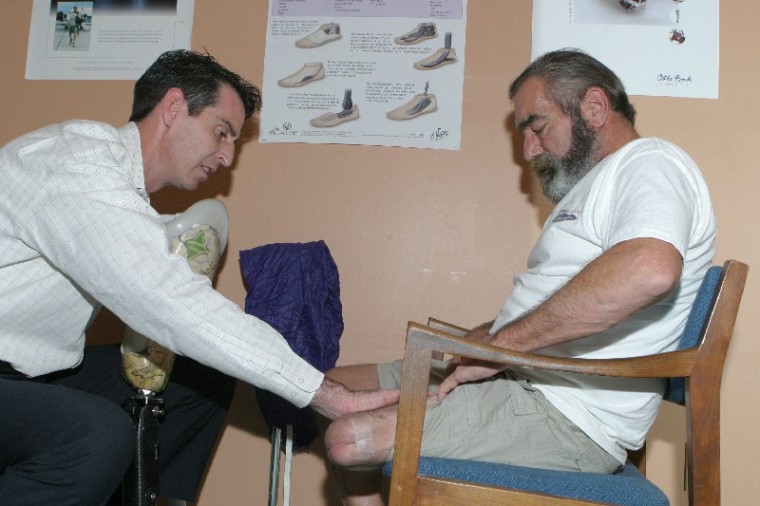
Hollister’s Wade Skardoutos crafts artificial limbs that enable
mobility
When Hollister’s Wade Skardoutos’s grandfather began his career
fitting prosthetics, he began a journey that would influence the
career choice of two of his grandsons.
Hollister’s Wade Skardoutos crafts artificial limbs that enable mobility
When Hollister’s Wade Skardoutos’s grandfather began his career fitting prosthetics, he began a journey that would influence the career choice of two of his grandsons.
Fitting prosthetics is a little-talked-about craft, yet for the people who need artificial limbs, there are few things more important.
The Skardoutos family recalls one relative of gramps who was fired from Ford Motor Co. when an on-site insurance examination revealed his legs were artificial – the result of a childhood accident.
Wade’s grandfather ended up fitting prosthetics for 45 years and taught Wade and his brother Jim the craft. Skardoutos began apprenticing with his grandfather when he was 14. As one of an estimated 3,500 prosthetists in the country, Skardoutos works two days a week as Hollister’s only prosthetist at his office, Prosthetic Solutions. Jim Skardoutos works at Central Fab, a company that makes prosthetic limbs.
Skardoutos sees about five patients a week at his office in Hollister, and up to 30 in his other office in Mountain View.
Eighty percent of his patients have lost one or more limbs due to vascular disease, many of whom have diabetes as well. As those who suffer from diabetes or have loved ones who do, the blood-sugar disorder and vascular disease go hand in hand, especially if they have not been careful in their diet.
The remaining 20 percent have lost one or more limbs due to congenital birth deficiencies or trauma such as injuries sustained in war or automobile accidents.
Patients are often referred to Skardoutos by the orthopedic surgeons who initially treated the patients. For some patients his first contact with them is when he comes in to help them change the dressings on their newly amputated limbs.
“We change the dressing on them every 48 hours, get them motivated, let them know we are going to get them walking, or using their arms again,” Skardoutous said.
When patients first come to him a cast is taken of their residual limb, from which a positive cast is crafted. The cast is then made into a mold from which a diagnostic clear socket is made. From this a limb is made (often at C/Fab, Jim Skardoutos’s company). Skardoutos is impressed with the modern innovations to prosthetic limbs. In terms of how they look cosmetically “we can match skin, hair and veins of the remaining limb,” he said. About 60 percent of his patients, however, choose a non-cosmetic limb – in effect choosing function over appearance.
With legs, the advancements have extended to a bionic leg that is driven by a worm gear that “sends signals to help patients go up stairs and slopes, like natural legs. Some legs are made with microprocessors that control swing and extension and don’t let the legs buckle, Skardoutos said.
Enabling amputees to live a relatively normal life is what makes Skardoutos anxious to go to work each day.
“Out of all the prosthetists in the Bay Area, I was the one selected to work with soldiers through the (U.S. Veterans Administration),” he said.
The VA makes sure that if one of its patients needs something, it covers it, he said. With private insurance companies, costs are more of a factor in coverage.
For example, swim legs (ones that can be used in water during heavy activity) would be beneficial for many people, and would help patients build their endurance, but many insurance companies won’t cover it, Skardoutos said. Insurance carriers often see certain things, like limbs that can be actively used in water, as a luxury.
“It’s not a luxury,” he said. “A luxury is something that is better than what God made and we’re not there yet,” he said.
The devices aren’t cheap. An above-the-knee leg computerized leg costs roughly $55,000, while an electric arm can cost as much as $35,000.
However, if a patient’s insurance company turns down a request, he can often work with the vendors to get the costs to a manageable level.
Skardoutos is proud he has helped many of his patients lead active and healthy lives. His youngest patient was a girl he met when she was 18 months old who had lost her leg after it had been chewed off by a Rotweiler.
“At first I just gave her something to crawl and balance on, later I was able to show her how to ride a two-wheeled bike,” Skardoutos said. “That’s what’s so great about my job; I help people do things they thought they couldn’t do again, there is no reward like that,” he said.
His oldest patient was a 97-year-old woman who wanted to leave an assisted living facility, but did not want to live with her daughters. She had lost a leg from vascular disease. He fit her with an above-the-knee prosthetic leg, and was able to live out the last year of her life independent.
His patients also include a man who competes as an “ultimate fighter” and two men currently training for the Para Olympics in 2008.
His patients stand behind his work. Tommy Millette, 58, an above-the-knee amputee who lost his left leg from vascular disease, began seeing Skardoutos when he became dissatisfied with the adjustments made by his previous prosthetist.
“[Skardoutos] made everything more accurate, the pieces going in, the filing down, and he always knows just what to do when I come in with a problem,” Millette said.
Danielle Stolman can be reached at ph***@**********ws.com.









